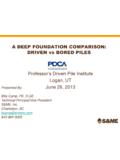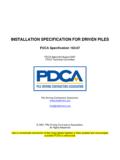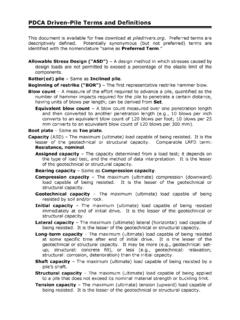Transcription of PDPI 2015 Static Axial Design of Driven Piles Chapters 8 & 9
1 PDPI 2015. Static Axial Design of Driven Piles Chapters 8 & 9. Design /Construct Objective To obtain an efficient (Economical). foundation system without compromising structure safety or service life Van will discuss Design Considerations Insertion of Piles generally alters soil character, and intense stresses are set up near Piles Complex soil-pile interaction Therefore, it is necessary to use practical semi-empirical Design methods Solution Requires Thorough Information & Understanding of: 1. Foundation loads 2. Subsurface conditions & soil/rock properties 3. Current practices in pile Design &. construction When a pile or any deep foundation is loaded until it fails what is it (what fails) ? Strength Considerations Two Failure Modes Pile structural failure controlled by allowable stresses Soil failure controlled by factor of safety ( ). (resistance factors - LRFD).
2 In addition, the ability to drive the pile is evaluated by wave equation yield stress 50 ksi Serviceability Considerations Factors arising from the action of service loads Axial , Settlement Lateral, Deflection Construction Considerations DRIVABILITY ( Design stage) ! Success depends largely on relating Static analysis results to dynamic methods of field installations Pile must be Driven to a resistance, or predetermined length, w/ reasonable BC. Satisfy Minimum tip requirements Avoid pile damage by excessive driving TIME EFFECTS ON PILE CAPACITY. Changes in pile capacity MAY. occur with time. Soil Setup Relaxation It is costly to ignore setup It is dangerous to ignore relaxation Frank and Pat to discuss later Soil Mechanics Review Angle of friction Undrained shear strength Unconfined Compression Strength Cohesionless Soils, Drained Strength Normal Force, N. F=N.
3 Friction Force, F. 1 = coefficient of friction between material 1 and material 2. 2. F. Tan ( ) = F/N. F = N TAN ( ).. N. Soil on Soil, we use . phi = angle such that TAN ( ). is coefficient of friction between Soil on Pile, we use material 1 and material 2. Cohesive Soils, Undrained Strength F. = zero c N. F = Friction resistance ; N = Normal force (stress). C is independent of overburden pressures c = cohesion, stickiness, soil / soil a = adhesion, stickiness, soil / pile Unconfined Compression Strength 1. 3. zero C. C = cohesion = qu 3. =0 Maximum 1 = unconfined compression strength, qu Static Analysis - Single Piles - Volume 1 Chapter 9. 9-19. Static Analyses of Driven Piles Lots of different methods ! Static CAPACITY. OF Piles IN. COHESIONLESS SOILS. METHODS OF Static ANALYSIS FOR Piles IN COHESIONLESS SOILS. Method Approach Design Advantages Disadvantages Remarks Parameters Meyerhof Empirical Results of Widespread use of Non Due to non Method SPT tests.
4 SPT test and input reproducibility of reproducibility of N. data availability. N values. Not values and Experience N Simple method to as reliable as the simplifying use. other methods assumptions, use presented in this should be limited to chapter. preliminary estimating purposes. Brown Empirical Results of Widespread use of N60 values not Simple method Method SPT tests SPT test and input always based on based of N60 data availability. available. correlations with 71. values. Simple method to Static load test use. results. Details provided in Section Nordlund Semi- Charts Allows for No limiting value Good approach to Method. empirical provided by increased shaft on unit shaft Design that is Nordlund. resistance of resistance is widely used. Estimate of tapered Piles and recommended Method is based on Part Theory soil friction includes effects of by Nordlund. field observations.
5 FHWA Part angle is pile-soil friction Soil friction Details provided in Experience needed. coefficient for angle often Section different pile estimated from materials. SPT data. 9-19. METHODS OF Static ANALYSIS FOR Piles IN COHESIONLESS SOILS. Method Approach Design Advantages Disadvantages Remarks Parameters Effective Semi- Soil value considers Results effected Good approach for Stress empirical classification pile-soil friction by range in Design . Details Method. and estimated coefficient for values and in provided in Section friction angle different pile particular by for and Nt materials. Soil range in Nt selection. resistance related chosen. to effective overburden pressure. Methods Empirical Results of Testing analogy Limitations on Good approach for based on CPT tests. between CPT and pushing cone into Design . Details Cone pile. Reliable dense strata. provided in Section Penetration correlations and Test (CPT) reproducible test data.
6 Data. 9-19. Nordlund Data Base Timber, H- Piles , Closed-end Pipe, Pile Types Monotube, Raymond Step-Taper Pile Sizes Pile widths of 250 500 mm (10 - 20 in). Ultimate pile capacities of 350 -2700 kN. Pile Loads (40 -300 tons). Nordlund Method tends to overpredict capacity 9-25 of Piles greater than 600 mm (24 in). Nordlund Method Considers: 1. The friction angle of the soil. 2. The friction angle of the sliding surface. 3. The taper of the pile. 4. The effective unit weight of the soil. 5. The pile length. 6. The minimum pile perimeter. 7. The volume of soil displaced. 9-25. d=D. sin ( + ). 9-27 Qu = K CF pd Cd d + t N 'q A t pt d= 0 cos . Nordlund Method For a pile of uniform cross section ( =0) and embedded length D, Driven in soil layers of the same effective unit weight and friction angle, the Nordlund equation becomes: Qu = (K CF p d sin C d D) + ( t N 'q A t p t ).
7 9-26. RS RT. Nordlund Shaft Resistance Rs = K C F pd sin Cd D. K = coefficient of lateral earth pressure Figures - CF = correction factor for K when Figure pd = effective overburden pressure at center of layer = friction angle between pile and soil Figure Cd = pile perimeter D = embedded pile length Nordlund Toe Resistance RT = T N'q pT AT. Lesser of RT = qL AT. T = dimensionless factor Figure N'q = bearing capacity factor Figure AT = pile toe area pT = effective overburden pressure at pile toe 150 kPa qL = limiting unit toe resistance Figure Nordlund Method Ru = RS + RT. and Qa = RU / FS. FS (Allowable Strength Design - ASD). based on construction control method see pg 9-14. Derrick to discuss LRFD. Nordlund Method Procedure Steps 1 through 6 are for computing shaft resistance and steps 7 through 9 are for computing the pile toe resistance STEP 1 Delineate the soil profile into layers and determine the.
8 Angle for each layer a. Construct po diagram using procedure described in Section b. Correct SPT field N values for overburden pressure using Figure from Chapter 4 and obtain corrected SPT N' values. Delineate soil profile into layers based on corrected SPT N' values. c. Determine angle for each layer from laboratory tests or in-situ data. d. In the absence of laboratory or in-situ test data, determine the average corrected SPT N' value, N', for each soil layer and estimate angle from Table 4-5 in Chapter 4. 9-28. Static CAPACITY. OF Piles IN. COHESIVE SOILS. METHODS OF Static ANALYSIS FOR Piles IN COHESIVE SOILS. Method Approach Method of Advantages Disadvantages Remarks Obtaining Design Parameters -Method Empirical, Undrained shear Simple calculation Wide scatter in Widely used (Tomlinson total stress strength estimate from laboratory adhesion versus method Method).
9 Analysis. of soil is needed. undrained shear undrained shear described in Adhesion strength values to strengths in Section calculated from adhesion. literature. Figures and FHWA Effective Semi- and Nt values Ranges in and Range in Nt Good Design Stress Empirical, are selected from Nt values for values for hard approach Method. based on Table 9-6 based on most cohesive cohesive soils theoretically effective drained soil soils are relatively such as glacial better than stress at strength estimates. small. tills can be large. undrained failure. analysis. Details in Section Methods Empirical. Results of CPT Testing analogy Cone can be Good based on tests. between CPT and difficult to approach for Cone pile. advance in very Design . Penetration Reproducible test hard cohesive Details in Test data. data. soils such as Section glacial tills. 9-42. Tomlinson or -Method Unit Shaft Resistance, fs: fs = ca = cu Where: ca = adhesion (Figure ).
10 = empirical adhesion factor (Figure ). 9-41. Tomlinson or -Method Shaft Resistance, Rs: Rs = fs As Where: As = pile surface area in layer (pile perimeter x length). Tomlinson or -Method (US). Figure Concrete, Timber, Corrugated Steel Piles D = distance from ground surface to bottom of clay layer or pile toe, whichever is less Smooth Steel Piles b = Pile Diameter 9-46. 3 Additional Boundary Conditions 1. Drive pile through Sa / Gr into clay layer 2. Drive pile through soft clay into clay layer 3. Drive pile into brittle surface clay layer 9-48. Tomlinson or -Method Unit Toe Resistance, qt: qt = cu Nc Where: cu = undrained shear strength of the soil at pile toe Nc = dimensionless bearing capacity factor (9 for deep foundations). Tomlinson or -Method Toe Resistance, Rt: Rt = qt At The toe resistance in cohesive soils is sometimes ignored since the movement required to mobilize the toe resistance is several times greater than the movement required to mobilize the shaft resistance.









